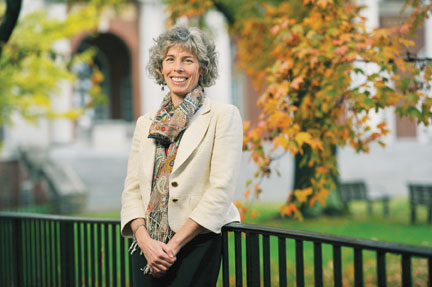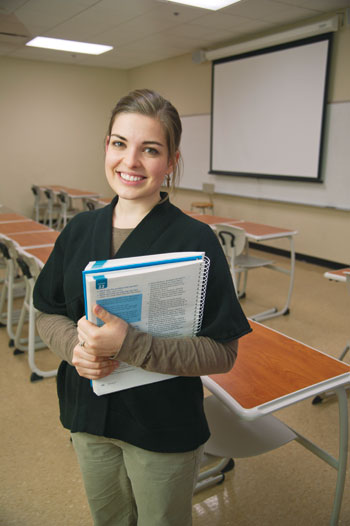 Public education has always been an arena in which the nation’s policy crises have played themselves out. Most pressing social and economic issues—segregation, immigration, unionization and union-busting, fiscal collapses, crime, drug abuse, unemployment—end up affecting schools and education policy.
Public education has always been an arena in which the nation’s policy crises have played themselves out. Most pressing social and economic issues—segregation, immigration, unionization and union-busting, fiscal collapses, crime, drug abuse, unemployment—end up affecting schools and education policy.
Today, once again, teachers find themselves grappling with change, as the nation responds to tough economic times and inadequate student achievement by asking schools to do more and more with strained resources. According to the Center on Budget and Policy Priorities, 37 states cut their per-student K-12 funding to local districts this year. Teachers face high-stakes testing in the classroom, new evaluation processes, combative public debates on unionization and limits to collective bargaining, a new licensing landscape that can pit traditionally educated teachers against those who have taken alternative routes, and school competition that turns up the heat on underperforming schools. While the potential for positive outcomes is real, in the short term, all this change creates a stressful, unsure environment in which to start a career.
Peabody’s faculty members know the pressure their newly minted teachers will face. Through their work—from innovations in curricula to research on issues such as teacher retention and satisfaction—Peabody responds to the evolving teaching environment and influences the policies that shape it.
Accountability and evaluation
Its vocal opponents notwithstanding, standardized testing is entrenched as the primary method that government officials and the public use to evaluate school and student performance. There are controversies—the federal Department of Education’s decision to grant waivers to districts that won’t meet No Child Left Behind’s 100 percent proficiency target by 2014, for instance—but none that threaten testing’s prominence in the public education system. Teachers who hope to succeed must feel comfortable with the use of metrics as an evaluative tool.
“Students who can reason deeply about subject matter and can communicate about it—these are the classrooms in which student achievement scores go up. We try to prepare our students not to narrow curriculum to testing demands.”
—Marcy Singer-Gabella
“We at Peabody have an increasing attention to assessment and using data to inform instruction,” says Marcy Singer-Gabella, professor of the practice of education and associate chair of the Department of Teaching and Learning. “We had a diagnostic approach to teaching, but we are expanding out in our use of resources to make sure that candidates are familiar with the tools they’ll find in schools and districts.”
The trick, however, is to use standardized data as a tool without losing sight of what research and experience show to be the most effective teaching methods.
“There is always the concern that tests are not aligned with what we know will sustain good student learning outcomes over time,” Singer-Gabella says. “How do you manage the balance between deep learning and more formulaic learning? We have research that says students who can reason deeply about subject matter and can communicate about it—these are the classrooms in which student achievement scores go up. We try to prepare our students not to narrow curriculum to testing demands.”
An important element of this is subject-specific pedagogy.
“It combines a rich understanding of subject matter with a rich understanding of learners, of what makes the material accessible to learners,” Singer-Gabella says. “We turn people into diagnosticians, so that they carefully evaluate students’ developing understanding.”
Teachers also face increased pressure from new evaluation processes that assess their performance according to their students’ standardized test scores and through direct appraisal in the classroom.

“In Tennessee this year, stemming from the Race to the Top, we have an accountability system that’s going into place that’s pretty intense,” says Kathy Ganske, professor of the practice of literacy and director of elementary education. “Hopefully the outcome will be exceptional teaching, but it’s not an easy process. There’s a lot of stress over it.”
The process determines teachers’ evaluation scores from three inputs: observation by principals or other instructional leaders (50 percent of score); student growth—i.e. value-added—data (35 percent); and student achievement data (15 percent). Established teachers are observed four times a year; new teachers, classified as apprentice teachers, are observed six times per year. At least half of the observations must be unannounced. Teachers receive a rating on a scale from one to five, and then these scores are applied to personnel decisions, such as professional development, tenure attainment and dismissal. For example, tenure eligibility will require a four- or five-level rating in each of the previous two years.
Fewer than two months into the new school year, complaints surfaced in the press that the new regimen overwhelms principal schedules, causes teachers to shift their focus from their students to their own evaluations, and even leads some teachers to quit.
The Murfreesboro City Schools went so far as to write a letter to the state’s education commissioner asking for relief: “We join your commitment to closing the achievement gap. However, we are having grave difficulty accepting the distraction from student learning that the current evaluation system demands. Therefore, we are asking you to revise the process … .”
Ganske says the teacher performance assessments (TPA) that Peabody students undergo help prepare the school’s licensure candidates for rigorous evaluation. TPA, which evaluates a candidate’s readiness for full-time teaching through an exhaustive set of reviews and self-assessments, was first developed in California in response to state law. Peabody is part of the consortium developing and piloting TPA in Tennessee.
“While it’s somewhat of a grueling process, it’s an excellent assessment,” Ganske says. “It’s scored by reviewers who are specifically trained in TPA. When students do not perform satisfactorily, we provide opportunities for them to remediate.”
Ganske adds, “Because we know they have TPA as part of their student teaching, we’re also threading things into our courses to prepare them, such as collecting video of practicum experiences, which can be looked at with a critical eye.”
There is concern, however, that the state’s evaluation process will make it harder for Peabody to place student teachers.
“Our veteran mentor teachers are still fine with having student teacher and practicum students, but others are nervous,” says Kimberly Paulsen, associate professor of the practice in special education and president-elect of the Tennessee Association for Colleges of Teacher Education. “They’re afraid to have novice teachers coming in, afraid they’re going to be evaluated poorly, or that achievement won’t be where it needs to be.”
Charters: competition and opportunity
High-stakes testing, which identifies weak schools and increases the demand for choice, has steadily ramped up support for charter school alternatives.
Some see charters as siphoning talent, funds and confidence from the wider public systems that they can never fully replace. In this view, the majority of teachers, still at traditional schools, are hurt by the resource drain and by weakened teachers unions that lose membership numbers. Others tout charters as public education’s best hope: they will provide superior schools and improve a district’s existing schools by incentivizing them through competition.

Research suggests the truth lies somewhere between. The best charters do phenomenal work; most have metrics comparable to traditional schools.
“I’m all for charter schools,” says Barbara Stengel, professor of the practice and director of secondary education. “It’s great if you can get people to build schools around a commitment. But the point of charter schools should be places of experimentation, so they can try things out that can come back and be adopted. Take KIPP. [Supporters] want every school to be a KIPP school. But we’re finding that good schools have good instructional leaders, whether they’re public or charter, rich or poor schools.”
For teachers, the charter school environment can be simultaneously invigorating and exhausting. Teacher attrition rates are high.
“I think there’s more freedom in how we implement programs and policies and things that are really good for our students,” says Brooke Fox Allen, BS’09, MEd’10, director of student supports at Nashville Prep. Allen taught for a year at Cora Howe Exceptional School in the Metro Nashville Public Schools before taking on a more administrative role at her charter.
“We are able to do things that are research-based that big districts aren’t able to do, because they don’t have support from the teachers, students, parents, the government,” Allen says. “But we’re governed by our board. We have a longer school day and school year, and our teachers go through so much more of a process. We keep data on everything, and then change policy in response to the data. It’s exciting to be part of a school that can change and improve in response to our students.”
“[Teaching] is becoming a two- or three-year career. But I can understand it, because I’m pretty stressed.”
—Brooke Fox Allen
Allen acknowledges, though, why many new teachers do not stay long in the profession. Between the high-stakes testing, the new evaluation system being implemented and the hours, time and energy it takes to be an effective teacher, the profession takes a toll.
“I don’t like that it’s so transitory for our students. It’s becoming a two- or three-year career,” Allen says. “But I can understand it, too, because I’m pretty stressed.”
Chris Barbic, BS’92, has taken a role that puts Tennessee at the forefront of charter school innovation. Barbic founded Houston’s YES Prep Public Schools, now a system of charters on eight campuses. In May 2011, Tennessee hired him as its first Achievement School District (ASD) superintendent. The ASD essentially will function as a district of charter schools spread across the state. School operators had until early October to submit applications to run charters for the ASD in 2012.
Power plays
Of challenges to teachers’ power within the public education status quo, none has erupted more angrily into the public square than efforts to limit collective bargaining by public sector employees. This was on most dramatic display in Wisconsin, where a capitol showdown between union supporters and the governor became a national spectacle. Other states have passed similar measures, or bills aimed specifically at teachers.
For now, the debate on whether unions help or hurt educational quality relies more on ideology than research. The relationship between unions, school policy, teacher performance and student learning is extremely complicated to measure; research thus far remains inadequate to drive decision making.
“There is a long-running narrative that teachers unions are bad for schools,” says Jason Grissom, professor of public policy and education. He notes that on average it suggests negative impact, but that the evidence is mixed, and that the scarcity of empirical data makes conclusions unreliable.
Last year, Grissom co-authored with Katharine Strunk of the University of Southern California a study that found evidence that stronger unions, through their power during collective bargaining, have greater influence over district policy, “negotiating contracts that are more constraining on the authority of administrators.” The study noted the potential implications of this finding, positive and negative. On the one hand were issues commonly associated with union power, such as administrators’ reduced control over personnel decisions. On the other were ways in which union influence might benefit districts. These included “the protection of teacher working conditions, which may decrease teacher turnover and enhance teacher productivity.”
“It is beyond the scope of this work to assess how contract restrictiveness affects student outcomes, although this area clearly deserves further attention,” Grissom wrote.
“One of the real difficulties when you study unionism—say, whether it positively or negatively affects student achievement—is finding your comparison group,” Grissom explains. ”In a lot of states, all the districts are unionized or not. And you can’t compare one state to districts in other states because the systems are so different. Membership gets confounded with so many other things that happen in schools.”
Education schools vs. new licensure paths
Like charter schools, alternative paths to a teaching career offer opportunities for innovation. Around the country, programs such as Teach for America have brought energy, enthusiasm and passion to struggling schools.
Still, conflict can arise when such alternatives serve not as complements to traditional professional training, but as rebuttals or threats.
“Last year, when I was looking for a job, Metro had put a freeze on hiring because they had to hire Teach for America teachers first,” Brooke Allen remembers. “I was livid. I’d been through five years of schooling and had a master’s. I was so frustrated. But then I got hired pretty early once that was lifted, and I didn’t teach with any nontraditionally licensed teachers
last year.”
Since moving to Nashville Prep, Allen has experienced Teach for America from a new perspective.
“I work in a world right now where our music and social studies teachers and I are the only traditionally trained teachers,” Allen says. “If you go into many of the Metro schools, it’s the Teach for America people who are most energetic and dynamic in their jobs and making more gains than many of the teachers who’ve been there for years. But then they leave.”
A study cited by Teach for America found that 61 percent of the program’s surveyed alumni continued teaching for at least a third year. Thirty-six percent taught longer than four years.
“I think Teach for America does some really good things,” Singer-Gabella says. “They recruit great talent, and get people excited about education. But one thing you see in alternative programs is persistence is not strong. Five years out, 70 percent of [Peabody] students who are recommended for licensure are still out teaching or are in masters programs with the desire to go back to the classroom.”
Robert Lundin, EdD ’09, who until recently served as Teach for America’s national vice president for university partnerships and now is a visiting professor at the University of St. Thomas in Houston, credits the program with changing his professional trajectory.
“I was one of the folks that arrived at Teach for America thinking this was going to be a two-year detour in my life, and education turned out to be my life’s calling. I loved the feeling that I had watching my students progress one by one,” says Lundin, who worked with Barbic at YES Prep after finishing his program commitment.
“In Teach for America, you take these two years and focus yourself laser like on student achievement,” Lundin says. “The organization makes it clear that whether you do this for two or 32 years, you need not only to embrace but fully understand the impact your role as an educator will have on students, schools and the communities you’re serving.”
“A teacher in this brave new world—highly politicized, contested and controversial—will not survive unless [he or she] can navigate the system.”
—Barbara Stengel
No end in sight
There is no sign that the pressure on teachers will let up any time soon. Budgets are still tight. Too many schools still fall short on achievement. Socioeconomic policies that might address the conditions that impact students outside the classroom—providing the “wraparound services” that they need—remain political poison.
 “As a teacher in this brave new world—highly politicized, contested and controversial—you will not survive unless you can navigate the system,” Stengel says. She tells students that it takes a lot more than expert classroom instruction.
“As a teacher in this brave new world—highly politicized, contested and controversial—you will not survive unless you can navigate the system,” Stengel says. She tells students that it takes a lot more than expert classroom instruction.
“How do you make your way?” Stengel asks. “You have to be someone who can articulate what you are doing and why. You have to be a community builder, and you have to be an articulate student advocate. You have to identify what is getting in the way of your students getting what they need. You won’t be a good teacher until you can do these things.”